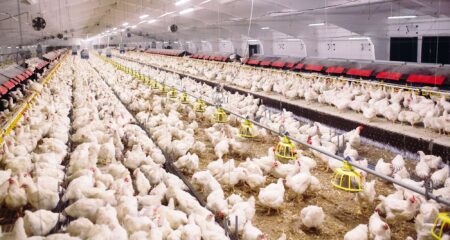The second report to seep out of the Make America Healthy Again Commission has pulled way back on attacking pesticides such as atrazine and glyphosate, a major focus of the commission’s initial effort back in May. Pretty much in line with a leaked draft from a few weeks ago, the Robert F. Kennedy Jr.-led commission is now focused largely on “reducing” the use of crop protection chemicals rather than taking the hardline restrictive approach he did previously.
This time, the 20-page MAHA Report — known as the Make Our Children Healthy Again Strategy — zeroed in largely on nutrition and lifestyle adjustments, including vaccines and food education, rather than advocating for tighter regulations on products that the commission may believe contributes to chronic illnesses in the U.S., particularly in younger people. The report was described as offering sweeping reforms that helped to better establish the importance of food and nutrition in the health of the nation’s children.
More than 250 groups representing farmers, ranchers, and crop protection researchers and manufacturers called for greater input into MAHA Commission activities following the release of the first report. The White House responded by holding meetings with numerous such groups over the summer.
During a recent Senate Finance hearing, Kennedy acknowledged speaking with more than 100 organizations and said that the food-production industry would have a vital role in the ongoing MAHA agenda. Among the agricultural-centric aspects of the second report was a focus on soil health and how the implementation of conservation practices and improved stewardship can have an impact on the quality of the food that’s grown.
“American agriculture shares many of the MAHA movement’s goals, such as improving the health of our children, as well as ensuring we are taking great care of the health of our land. We are only as healthy as the soil our food comes from, and there is a role to play for both industry and the public sector,” the Fertilizer Institute said in a statement.
The report encourages key agencies to collaborate on a framework to study synthetic pesticides and other chemical components. This is significant because the use of crop protection products has created tension between MAHA activists, including some widely known social media personalities, and Republican politicians who draw major support from production agriculture.
“USDA and EPA will launch a partnership with private-sector innovators to ensure continued investment in new approaches and technologies to allow even more targeted and precise pesticide applications,” the new report said. “This can support increased crop productivity and reduce the total amount of pesticides needed. These partnerships should focus on precision application methods, including targeted drone applications, computer-assisted targeted spray technology, robotic monitoring, and related innovations.”

Unlike when the first report was released, the second report hasn’t drawn the immediate and overwhelming backlash from agricultural stakeholders, and some, like The Meat Institute, praised this new report’s willingness to include meat products as a component of healthy diets.
“Science has shown what American parents have known all along: nutrient dense meat and poultry products are essential to a well-balanced diet,” said Meat Institute President and CEO Julie Anna Potts. “For years, previous administrations have tried to discourage consumption of meat, primarily for reasons unrelated to nutrition, and as a result our most vulnerable populations – children, adolescent girls, nursing mothers and seniors — no longer consume enough protein and critical nutrients like iron and zinc.”
From a food consumption perspective, Kennedy’s Make Our Children Healthy Again Strategy includes:
- Dietary Guidelines for Americans (DGAs): The U.S. Department of Agriculture and Health and Human Services will launch an education campaign based on the updated DGAs. The campaign will expand upon a DGA that prioritizes whole foods including protein foods, fruits, and vegetables, minimizes highly processed foods, and added sugar, and brings awareness to strategies to improve health.
- “Healthy Foods and Healthy Families”: Empower families with practical knowledge, including food preparation methods, to make healthy choices regardless of budget or location.
- Food for Health: The HHS, USDA, and Veterans Affairs will study the impact of programs that implement food and lifestyle interventions to improve health outcomes and decrease costs. The NIH Office of Nutrition will coordinate research initiatives to improve rigorous studies and maximize impact, including through large-scale randomized control trials.
- Nutrition: The National Institutes of Health will partner with the Food and Drug Administration, the USDA, and the newly planned Administration for a Healthy America to conduct high-quality nutrition research and ingredient assessments. The NIH and HHS will take steps to fully utilize the FDA and NIH Joint Nutrition Regulatory Science Program. The USDA will prioritize precision nutrition research, which identifies how dietary exposures impact individuals, leading to more targeted nutritional recommendations. The HHS will add questions to the National Survey of Children’s Health that focus on nutrition.
- “Food for Health”: Emphasize how proper nutrition prevents and can help reverse chronic diseases and maintain general health.
It’s likely we’ll see a continued positive response from agriculture because of the revised tone in the second MAHA Report.
A National Corn Growers Association survey — conducted between June 17 and July 2 with more than 1,000 growers — showed that losing access to herbicides such as atrazine and glyphosate would lead to higher costs and reductions in crop yields. The growers overwhelmingly indicated (85 percent) that weeds are the top pest plaguing their crops and that these were their top two herbicides of choice.
“These [survey] results are in line with what I am hearing in conversations among farmers,” said Illinois farmer and National Corn Growers Association President Kenneth Hartman Jr. “We are concerned that claims about herbicides in the pending MAHA recommendations could remove access to the tools we need to safely and sustainably produce a crop.”
The crop protection tools in question have been thoroughly tested by the U.S. Environmental Protection Agency and other regulatory bodies and shown to be safe for their intended uses. Independently, nearly all scientific bodies and associated research have also affirmed the safety of glyphosate.


Generally speaking, Kennedy and his allies are now advocating for building trust in the pesticide regulatory-approval process, rather than doing a knee-jerk restriction on products.
It prompts the EPA to “increase the timely availability of more innovative growing solutions for farmers,” and to “work to ensure that the public has awareness and confidence in EPA’s pesticide robust review procedures” in conjunction with food and agricultural groups.
“The Commission’s Strategy importantly acknowledges how EPA’s transparent, science and risk-based regulatory system is key to a safe and sustainable food supply,” CropLife America said in a statement. “The United States regulatory system for pesticides is recognized as the gold standard around the world, and it is critical that American farmers and consumers can continue to trust the rigorous process and oversight.”


:max_bytes(150000):strip_icc()/IMG_1591-2048x1365-362687ca596f4814967abffff2b4be2c.jpg)
:max_bytes(150000):strip_icc()/SuccessfulFarmingShareImage-8fed6410b43147a19ed5ea1e3243227f.png)





:max_bytes(150000):strip_icc()/IMG_7575-ac6db3006a2145109bcc2df421c7a962.jpeg)

:max_bytes(150000):strip_icc()/Markets-3-Corn-up-3-19bdbeee0041452db8bce0a0f1c8b883.jpeg)